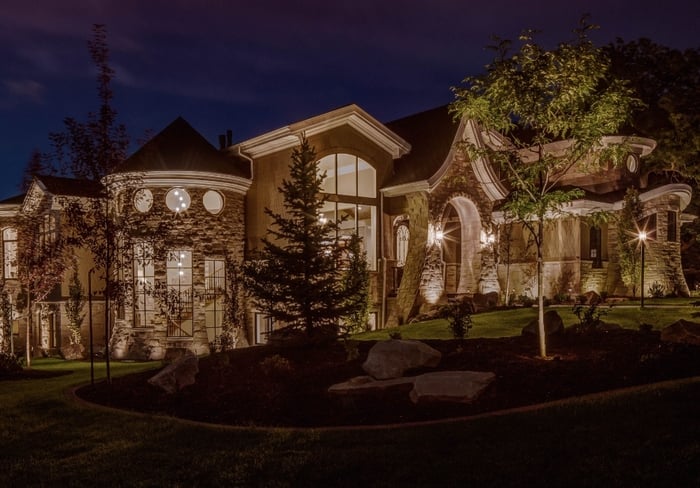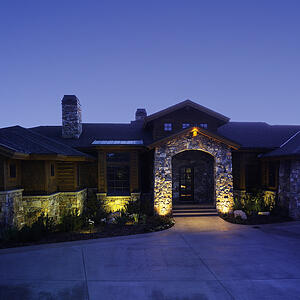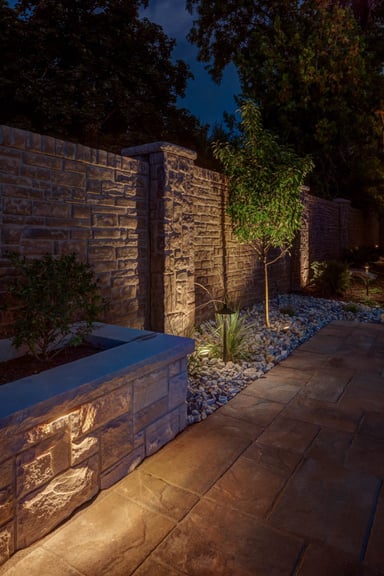The best techniques to properly flood your house

First, let me get something out in the open. I don’t really like the term “floodlighting.”
It sounds like you put one huge light in front of your house and, boom! Your home is blasted with a flood of stark light.
Grab your sunglasses and kiss any of the beautiful details of your home’s architecture goodbye.
The sad thing is, that’s exactly what some homeowners do.
Like any aspect of good professional landscape lighting, there’s an art to this type of lighting.
Let’s take a look at how to properly floodlight your house.
First, what is floodlighting?
Floodlighting is a basic element of landscape lighting.
When floodlighting a house, lights are placed low in the landscape and directed up at your house.
They cast a wide beam to offer a wash of light that highlights the architectural features of your home.
The idea is to bring inviting warmth to the front of your house.
This is your curb appeal lighting, to be appreciated from the street.
But it serves other purposes, too, including security lighting, as well as accent lighting for your home’s unique features.
You need more than one light

But it isn’t meant to stand alone. The best home floodlighting is combined with other layers for an entire palette of light.
The goal is balance and composition.
We look at the architectural features you want to highlight and bathe them in light. Maybe your nice dark brick facade, or stonework, or heavy timber gables.
Layering is important — not just flooding the dormers and the chimney with light.
Other layers of light that work in harmony with floodlighting are path lighting along your walkways and up your steps. Uplighting that stand of pine trees and your pretty redbud tree. Downlighting your flower beds, so it all looks bathed in moonlight.
Balance is key
We might light the columns on the front of your home, and those striking timber gables 20 feet away, but what about the spots in between?
A lateral floodlight is perfect for those in-between spots.
We use narrower beam spreads to highlight the vertical features of your home, and wider beam spreads for the horizontal features.
We might break out one of the tricks of our trade — a “spread lens.” This accessory affixes to the front of the bulb to spread out the light.
Choosing floodlight fixtures
The bulbs do the heavy lifting in floodlighting, but the fixtures are important too. They need to be aesthetically pleasing and fit the space.
For example, we would likely choose a lateral wash light fixture for your home’s floodlighting, rather than a bullet fixture.
A lateral wash fixture has a softer oval shape that is suited for aiming a wide, 120-degree spread of light toward your house.
We also choose fixtures that will blend and hide best in the landscape. We want you to see the light, not the source.
We take your lifestyle into account when we select fixtures for your home’s unique lighting needs. If the space is a high-traffic area, or if you have lots of kids or parties, we might use in-ground floodlights that are flush with the ground so they won’t be trampled.
The advent of LED lighting means that we can get away with smaller, less obtrusive fixtures for floodlighting. This is just one more advantage to the beauty of LED landscape lighting.
A word About floodlighting new construction

A new home with new landscaping needs a different lighting treatment than an established home with mature trees.
If you have a new startup tree, we can put a single lamp on it with a 2-watt bulb that offers a nice soft beam spread. The light won’t overwhelm it.
Then, in eight years or so, when the tree is three times bigger, we can switch the bulb for a 5-watt lamp, or add a second fixture if needed.
Your lighting system can grow as your landscape changes.
Wash, don’t flood
If you want your house to look like it belongs on the Las Vegas strip, by all means, go for it.
But if you want elegant, tasteful, artistic floodlighting for your house, you can’t just grab four 150-watt floodlights from the big box store and line them up.
That just aims a stark blast of light at your home that washes out all the nice architectural features that make your house unique.
This is where professional expertise comes in.
Skilled lighting artisans have the know-how and acumen to choose the right blend of lighting to subtly wash your home with light, not flood it beyond recognition.
Sure, I could put a 400-watt light on a pole on top of your house and light your whole front yard. But it’s not a parking lot.
More isn’t always better.
We’re trying to create an atmosphere, and it takes a lot of different pieces, working together, to do that.
Ready to floodlight your house properly?
To learn more about how artistic, skilled floodlighting can beautify your home and landscape, call us at (801) 440-7647 to schedule a free consultation, or fill out our simple contact form.
Located in Midvale, Landscape Lighting Pro of Utah serves customers throughout Utah’s residential areas, including Salt Lake City, Park City, Draper and Holladay. Our outdoor lighting portfolio includes projects from Salt Lake County and Utah County, to Davis County and Summit County — and beyond.
Salt Lake City (Midvale)
801-440-7647
St. George
435-932-6627
©2024 Landscape Lighting Pro